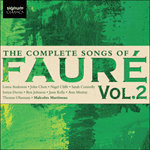This song’s beckonings correspond to Gounod’s
Où voulez-vous aller? or Duparc’s
L’invitation au voyage. In Silvestre’s collection,
Les ailes d’or, the second half of the poem is a Baudelaire-like sequel personifying the ominous dreams of the past. But there is nothing disturbing here, and the music rocks us gently, benignly, into the stratosphere. We wander high above the world’s gardens and the fragrance of jasmine. There are passages in this song where the musical discourse wanders into the indeterminate ether in a manner of which no other French composer of the time was capable. Fauré’s harmonic excursions are usually underpinned by strong bass lines, but here, as in another Silvestre setting,
La fée aux chansons, the composer abandons the F clef for much of the time in favour of higher, more etiolated regions. There are delicious ambiguities here, for example the pivotal role played by E flat (D sharp) in the keys of A flat major (dominant) and E minor (leading note). Jankélévitch hears similarities with Wolf’s
An eine Äolsharfe composed only four years later. The two songs share a berceuse rhythm and an other-worldly evanescence, but Silvestre is clearly no Mörike, and it is Fauré’s harmonic refinement that disguises his poet’s sentimental streak.
from notes by Graham Johnson © 2005
Cette mélodie a les charmes d’
Où voulez-vous aller? (Gounod) ou de
L’invitation au voyage (Duparc). Dans le recueil de Silvestre,
Les ailes d’or, la seconde moitié du poème est un prolongement à la Baudelaire, où sont personnifiés les rêves alarmants du passé. Mais il n’y a ici rien de dérangeant et la musique nous berce doucement, aimablement, dans la stratosphère. Nous vagabondons bien au-dessus des jardins du monde et de l’odeur des jasmins. À certains moments, le discours musical erre dans l’éther indéterminé d’une manière dont nul autre compositeur français de l’époque n’était capable. Les incursions harmoniques de Fauré sont généralement étayées par de puissantes lignes de basse, mais ici, comme dans
La fée aux chansons (également sur un poème de Silvestre), la clef de fa est souvent délaissée au profit de sphères supérieures, plus étiolées. De délicieuses ambiguïtés se font jour, tel le rôle crucial de mi bémol (ré dièse) dans les tonalités de la bémol majeur et de mi mineur. Jankélévitch y perçoit des similitudes avec
An eine Aeolsharfe, composé par Wolf juste quatre ans plus tard. Ces deux pièces partagent un rythme de berceuse et une évanescence éthérée, mais Sylvestre n’est à l’évidence pas Mörike, et c’est par son raffinement harmonique que Fauré parvient à dissimuler le penchant sentimental de son poète.
extrait des notes rédigées par Graham Johnson © 2005
Français: Hypérion


 Fauré: The Complete Songs, Vol. 2
Fauré: The Complete Songs, Vol. 2
